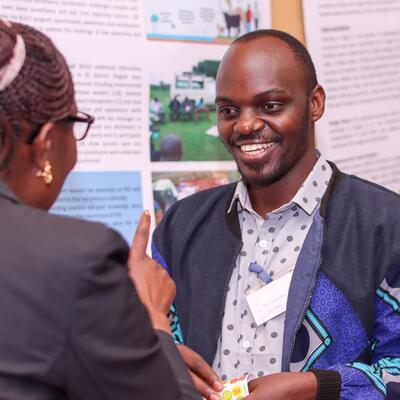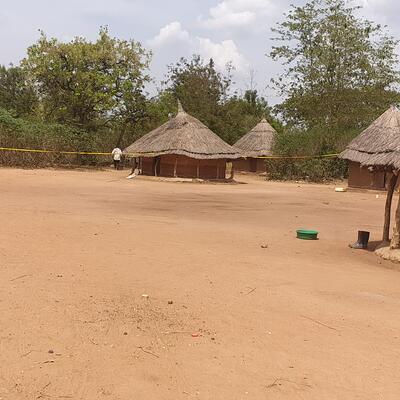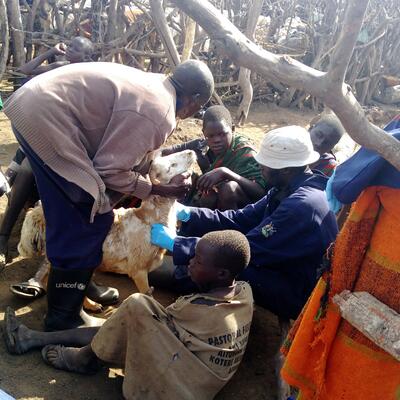
Stakeholders call for more collaboration in Rift Valley fever surveillance and control in Uganda
Stakeholders working on Rift Valley fever (RVF) virus have called for inclusion of RVF in Uganda’s national One-Health platform activities and facilitation of networking and collaboration among One Health partners nationally to better manage RVF outbreaks and promote timely information sharing about the disease.
The hybrid meeting, held in Kampala at the end of April 2021 physically and online with stakeholders in Nairobi and Germany, was organized by the International Livestock Research Institute(ILRI)-led Boosting Uganda’s Investment in Livestock Development (BUILD) project’s RVF component to review the existing RVF surveillance and control measures in the country. The event also aimed to identify opportunities and entry points which the BUILD project can use to support RVF surveillance and control and determine how to coordinate activities of various partners. The meeting sought to guide the project in developing and deploying priority risk-based intervention measures in line with Uganda’s existing RVF management policies and strategies.
In attendance were representatives from the Ministry of Agriculture, Animal Industry and Fisheries (MAAIF), Ministry of Health (MoH), the National One Health Platform, the United Nation’s Food and Agricultural Organization (FAO), World Organisation for animal Health (OIE), the Uganda Virus Research Institute (UVRI), Vétérinaires Sans Frontières-Germany (VSF-G) and ILRI.
Speaking from Nairobi, the OIE Sub-regional Representative for Eastern Africa, Chadia Wannous, noted that the OIE is working on RVF through the global framework for the progressive control of transboundary animal diseases, with the aim of protecting the health of animals. She identified the importance of collaboration between stakeholders as a key component in preventing and responding to RVF:
‘RVF is a regional complex issue and of international concern, therefore collaboration between countries is important for the successful implementation of control measures.’ She added that tackling RVF ‘requires a One Health approach, making collaboration among the various players important for the prevention and control of outbreaks.’
Partial results from ongoing research to develop an RVF risk map for Uganda indicate that more samples from districts in the central region, along Lake Victoria and the River Nile tested positive for RVF than from elsewhere, and that mainly adult male crossbreed cattle were at high risk of RVF infection. The research also found that there were cases of RVF infection in cattle in districts with or without human outbreaks. The risk factors for RVF infection included grazing cattle in lowlands, tethering and paddocking production systems, animals with a history of abortions as well as animals from large herd sizes of more than 50 cattle. Other RVF research being conducted in Uganda include RVF risk modelling and prospective sampling by ILRI and MAAIF; testing of other animal species, besides cattle, sheep and goats, for RVF infection and human serosurveys by the Uganda Virus Research Institute.
Dan Tumusiime from Uganda’s MAAIF and a BUILD project PhD fellow noted that MAAIF is mandated to undertake surveillance of priority animal diseases in the country, with districts veterinary officers playing a key role in district-level disease reporting. Surveillance units comprising of veterinary staff in 920 sub-counties have been established, with farmers and communities and non-governmental organizations (NGOs) being the starting points of the surveillance systems, though this is often delayed by inadequate resources. Tumusiime added that health education is key in the control and prevention of RVF in Uganda.
‘As RVF outbreaks in animals usually precede human outbreaks, it is important that animal health is monitored and signs of RVF such as abortions communicated not only to the veterinary officers but also the health departments in a district and to the central government,’ he said.
He reiterated the need for collaboration among RVF stakeholders especially in the areas of surveillance, outbreak and response data collection, analysis and dissemination as a means of informing and guiding policy action and identified some collaborations that have been beneficial to MAAIF including support from the United States Agency for International Development (USAID) to transform the current paper-based reporting system into a web-based infectious diseases detection system (IDDS); FAO has also supported the development of a mobile-based app that allows reporting in real time and the redesigning of the Animal Resources Information system (ARIS 2) by OIE into ARIS 3. The improved reporting systems will improve data sharing among stakeholders.
Other RVF management interventions in the country include capacity development for animal health service providers under the BUILD project led by VSF-G on participatory disease surveillance. So far, 45 personnel from 36 districts have benefitted from the training that provides valuable information collected from the livestock keepers, which facilitates better understanding of disease, awareness creation and effective disease detection by scientists, with support from the communities. Participatory disease surveillance also fosters strong relations between animal health service providers and livestock owners.
Other areas proposed for collaborative action include determining the minimum response time taken to mobilize rapid response teams when an outbreak alert is received, and standardization of data collection protocols and tools as well as data sharing among stakeholders. Participants emphasized the need for transparency in sharing outbreak reports with the relevant regional and international institutions and ensuring all official documentation is in place at the end of outbreaks.








